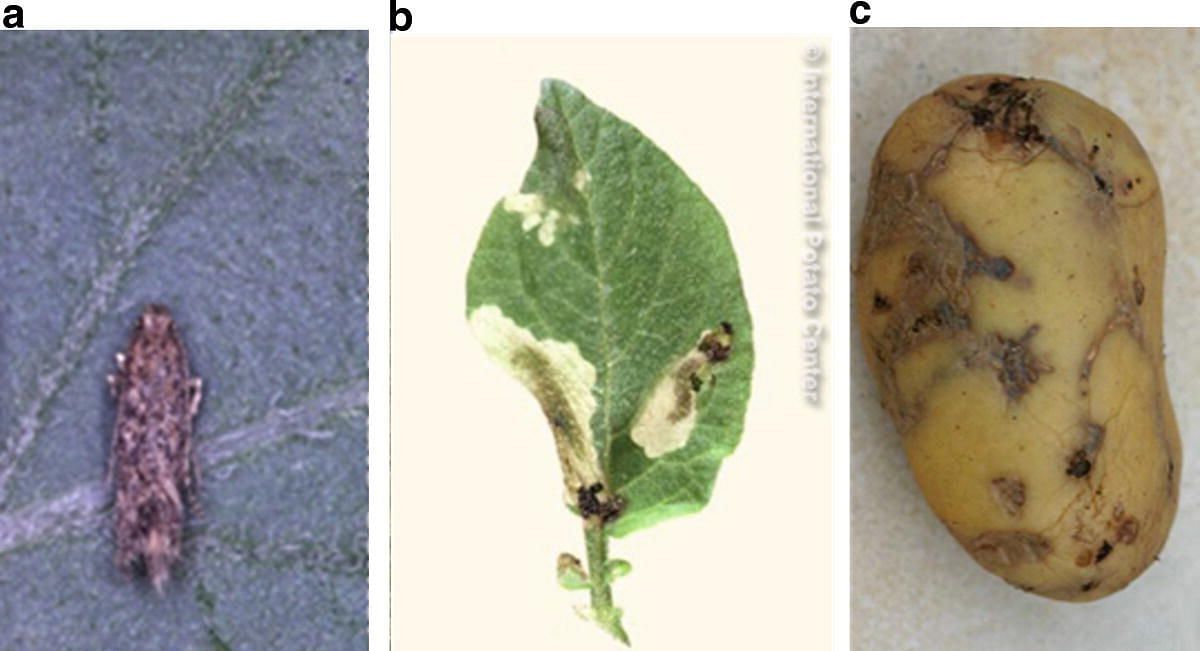Scientific description of the Tomato Tuber Moth (2020)
Based on J. Kroschel. et al. (2020) Insect Pests Affecting Potatoes in Tropical, Subtropical, and Temperate Regions. In: Campos H., Ortiz O. (eds) The Potato Crop. Springer, Cham
The authors of this content are Jürgen Kroschel, Norma Mujica, Joshua Okonya, Andrei Alyokhin
Tuta absoluta (Meyrick) (Lepidoptera: Gelechiidae)
Distribution
The tomato leaf miner, Tuta absoluta, was first identified in Peru by Meyrick in the year 1917 from samples collected in Huancayo (3200 m above sea level) (image below). Since then, it has been recorded in all South American countries. The pest is predominantly found in areas below 1000 m asl.
It was first introduced into Europe in Spain in 2006, from where it is believed to have spread to other European countries. Its range has expanded considerably to Asian and African countries in recent years (CABI 2017k).

Adult of Tuta absoluta (a), larvae infestation on potato leaf (b), and tuber (c). (Courtesy: CIP)
Host range
Hosts of T. absoluta are the cultivated Solanaceae tomato, potato, eggplant, sweet cucumber (Solanum muricatum L.), and tobacco. Other cultivated host plants are slender amaranth (Amaranthus viridis L.), groundcherry, and the Johnson grass (Sorghum halepense (L.) Pers.).
Noncultivated Solanaceae hosts include a wide range of weeds such as Lycopersicon hirsutum Dunal, Lycopersicum puberulum Ph, Solanum americanum Mill., S. bonariense L., S. elaeagnifolium L., S. hirtum, S. lyratum, S. nigrum L., S. puberulum, S. sisymbriifolium Lam., S. saponaceum, Datura stramonium L. (jimsonweed), D. ferox L., Nicotiana glauca Graham, Lycium chilense (Bertero), Lycopersicon pennellii var. puberulum (Correll), Solanum dubium Fresen, and Solanum puberulum Phil.
Symptoms of infestation
On potato, T. absoluta attacks aerial parts and occasionally tubers. Foliar damage is a result of mine-formation within the mesophyll by the feeding larvae. The newly emerged larvae are quite mobile and begin their feeding by building galleries on the leaflets.
Depending on the place of oviposition, a larva may penetrate leaf mesophyll, leaf petiole, and young shoots. The mines expand as the larva develops, causing deformation or rot of the affected leaves.
The larvae can migrate to another part of the plant, especially when they reach their maximum development or when the affected foliage withers and dries (CIP 1996; Notz 1992; EPPO 2005b).
Impacts on production losses
T. absoluta is a major pest of tomato (Lycopersicum esculentum), but it also attacks potato. Larval feeding causes desiccation of damaged leaves and shoots, resulting in low tuber production. Larval damage is generally accentuated in young plants in the tuberization phase.
Possibilities of T. absoluta infestation of potato tubers are very low and restricted to very high field infestation rates during the last stage of the crop (CIP 1996; CABI 2017k; OIRSA 2015b; SENASICA 2016).
Methods of prevention and control
- Monitoring with pheromone traps.
Pheromone traps can be used both for early detection and for monitoring the flight activity of the pest. They can also help to reduce the population when used for mass trapping, in which case a higher number of traps need to be deployed. For monitoring purposes, one trap should be placed per hectare (Niederwieser 2017; OIRSA 2015b). - Cultural practices.
Good agricultural practices for the control of T. absoluta include crop rotation with non-solanaceous crops (preferably cruciferous crops), ploughing, adequate irrigation and fertilization, removal of infested plants, and complete removal of post-harvest plant debris. - Biological control.
Nesidiocoris tenuis Reuter is an efficient predator of eggs and small larvae of the tomato tuber moth. Egg parasitoids of the family Trichogrammatidae are the natural enemies most used worldwide in biological control programs against Lepidoptera, through inoculative and inundative releases.
Releases of Trichogramma pretiosum Riley reduced the population of T. absoluta to a maximum of 49%. Therefore, combinations with the application of a bioinsecticide based on Bacillus thuringiensis subsp. kurstaki have been recommended (Niederwieser 2017). - Botanicals/Biopesticides.
Neem oil (Azadirachtin) acts as a contact and systemic insecticide and has been shown to be effective against low infestations of T. absoluta and for controlling first and second instar larva. The use of Bacillus thuringensis is recommended at low-medium infestation levels in combination with Azadirachtin (SENASICA 2016). - Chemical control.
Several insecticides have been effectively used against T. absoluta in potato; however, this pest is known to develop resistance against effective insecticides.
